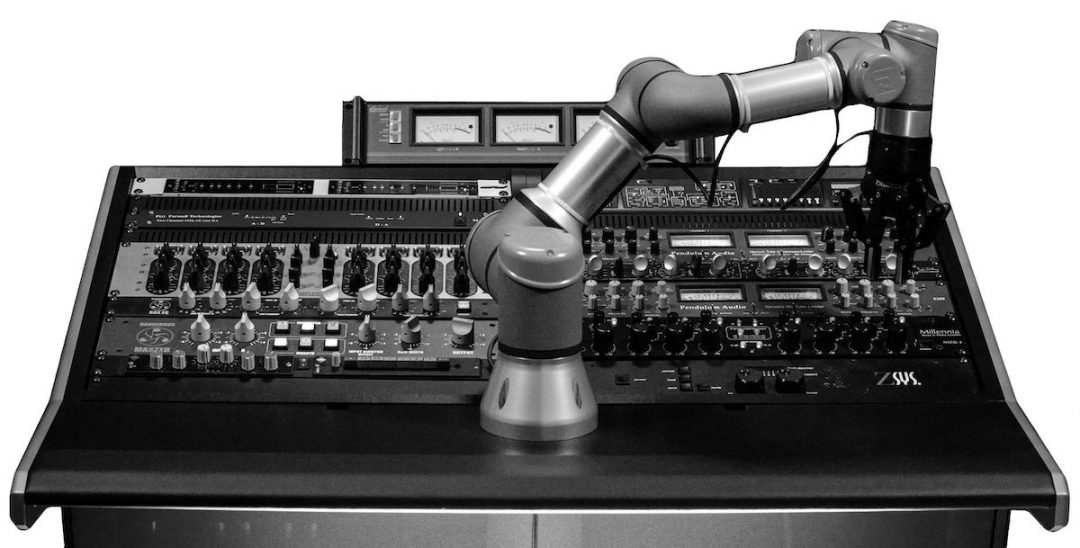Online mastering services have taken the industry by storm over the past several years. These automated systems promise professional mastering, delivered instantly—all for a very reasonable price. This is attractive and convenient to artists looking for fast, affordable turnaround. Aria Mastering is leading the pack, thanks to its unique approach to the online mastering machine.
What is Aria Mastering?
Mastering engineer Colin Leonard (Jay Z, Justin Bieber, Mastodon) developed Aria at his studio, SING Mastering, in Atlanta. The Aria process is a unique hybrid digital-analogue approach, using the same outboard equipment Leonard utilizes.
Now, you’re probably wondering how an automated service could use analogue equipment, and it’s actually quite innovative. Aria literally uses a robotic arm to operate outboard mastering gear based on one of 5 presets you can select for the given material.
The Aria server, computers, and equipment are all located at Leonard’s studio in Atlanta. Your upload goes through the website directly to their studio computer. This keeps your music secure, but also allows for faster upload and download speeds—win-win. Once Aria gets the song, the robot arm masters it in real time, sending you a mastered track within a few minutes.
- SEE ALSO: Home Studio Mastering with Ian Shepherd
How does Aria work?
Aria Mastering is a subscription service. The base package starts at $49/month and lets you upload 10 individual tracks for mastering. For the average artist, that’s probably more than enough, weighing in at roughly an album’s worth of mastering every month. You can also just opt to master a single song for $19 if you don’t want to subscribe.
The automation is based on 5 ‘Mix Type’ settings that you choose depending on the kind of song you have:
- A – Moderate: Best suited to dynamic mixes, such as acoustic or classical songs
- B – Loud: (Default Level) Standard modern mix with moderate compression
- C – Louder: Best for balanced mixes that have already tastefully used compression; works great for loud genres like hip-hop or EDM
- D – Loud/Safe: Best for softer songs that need to be loud; it’s sort of a hybrid between A and B for a balance between loudness and dynamics
- E – Extra Dynamic: Suited for a cappella, delicate acoustic or classical recordings, dainty film scores, etc.
Most of the time, Aria works well if you choose the appropriate Mix Type. However, if you’re not satisfied for any reason, you have the opportunity to remaster the same track an additional 5 times until you’re satisfied. That means you could run through all of the settings before you decide what sounds the best to you.
As far as deliverables go, each master comes back at 16-bit/44.1 and 24-bit/44.1. For another ten bucks, you could request a 48 kHz master if needed. There’s also a MFiT option (Mastered for iTunes) if you plan to sell your music on that platform. Again, that’s an additional $10/song, but you don’t need those masters if you don’t upload to iTunes.
One thing to keep in mind before using Aria Mastering is to prep the files accordingly. That means trimming and fading the song to your liking beforehand, making sure your bounce isn’t already limited for loudness, and leaving a bit of pre- and post-roll at the head and tail of the track.
From there, give it a whirl and see if works for you!
Aria Mastering vs. LANDR vs. eMastered
The biggest difference between Aria Mastering, LANDR, and eMastered is that the former uses that crazy robotic arm to twist the knobs on real analogue equipment. The other two use digital algorithms, which are also very effective—but you won’t get that potential analogue mojo, if that’s something that matters to you.
LANDR is straightforward and easy to use, with different subscription plans offering additional services. For $48/year, you can get a quick and dirty master on unlimited songs using a reference track to tailor your unique master. A step above that is $108/year, which introduces more features for added customization over your master.
With eMastered you get the most bang for your buck out of a one-year commitment, which is billed at $13/month upfront, or $19 month-to-month. A one-month subscription will run you $49 like Aria Mastering. eMastered offers the most customization, giving you control over EQ, stereo width, volume/compression, and more.
Ultimately, you’d need to hear each of these in order to make a decision. Aria Mastering is the most innovative, for sure, using AI and robotics to deliver an analogue master. Based on that alone it’s worth a try, though you may find yourself perfectly happy with the simplicity of LANDR.
Conclusion
Aria Mastering is undoubtedly pushing the boundaries of automated online mastering. It’s still no replacement for a real human engineer, but those things are oftentimes expensive and busy, so the average emerging artist would probably settle for letting a computer do the work.
